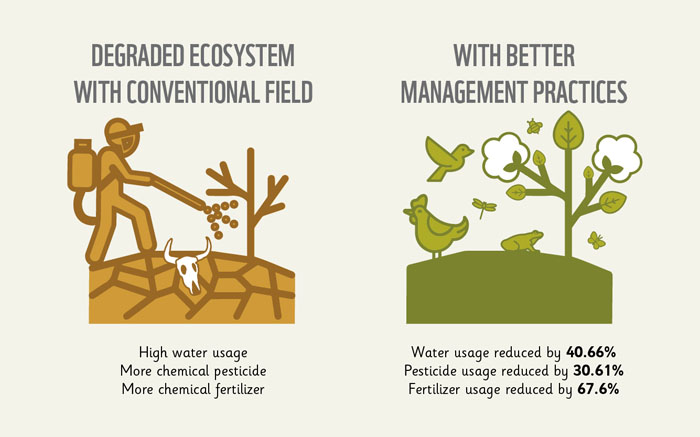Impossible is the word if you were to imagine your life without cotton, its literally wrapped in it. Growing cotton has environmental risks owing to its high water footprint and pesticide usage and if we do not adopt sustainable and better ways to grow cotton we shall be baring our ecosystem, biodiversity and human health to high risks.

Pesticides used in cotton farms get mixed with water and enter the soil and water table. Further through a process called ‘biomagnification’ these hazardous chemicals travel upwards in the food chain, into human bodies impairing health. In other words, the less chemical pesticides we use the better it is for the health of the ecosystem, including human health.

WWF-India has been working with about 20,000 cotton farmers, in an area near Godavari river basin (Telangana) to find out better ways of growing cotton. Better Management Practice or BMP as it is called works on 3 specific areas –Soil, Water & Pesticide management and the results are eye opening. BMP fields show an approximate 40% drop in usage of water and pesticides.

Biodiversity thrived in cotton fields under Better Management Practices as compared to conventional fields. Evidence of greater number of visits of birds, insects, amphibians and other species showed a remarkable increase. Indian Bull Frogs presence was more than double in BMP fields. The number of Butterflies & moths (Lepidopterans), Dragonfly (Odonates), Spiders, Scorpions (Arachnids) and other invertebrates visited 26% more in BMP fields and had a role to play in growing cotton in a less harmful manner, naturally.
This small Warbler is farmer’s best friend.
If you sit around in a BMP field for a little while you will see this small little bird keeping itself busy hovering over the cotton plants. Ashy prinia, is a resident breeder in the Indian sub-continent, and spends 91% of its time in the cotton field controlling pest populations reducing the dependency on chemical pesticides without affecting production.

Today man has become the biggest threat to the health of the planet. 60% wildlife populations have been lost in less than 50 years (Living Planet Report 2018). We are the first generation to know what we’re doing, and the last who have a chance to put things right.
“WHAT WE DO NOW, AND IN THE NEXT FEW YEARS, WILL PROFOUNDLY AFFECT THE NEXT FEW THOUSAND YEARS”
There are small changes that we can make right now in our everyday lives. When we come together to make these small changes, they can make a big difference.